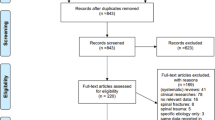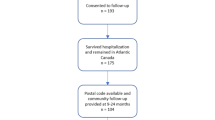Abstract
Study design:
Narrative literature review.
Objectives:
To (1) summarize epidemiological and scientific research on spinal cord injury (SCI) populations from three severe earthquakes (EQs) in rehabilitation resource-scarce settings; (2) summarize SCI rehabilitation services by local and foreign providers in response to these EQs and (3) provide implications including research gaps for a supporting global scientific research agenda.
Setting:
International.
Methods:
A literature review was conducted using PubMed to identify epidemiological studies reporting data on SCI survivors of the 2005 Kashmir EQ in Pakistan, the Sichuan EQ of 2008 in China and the 2010 Haiti EQ. A follow-up review on the SCI rehabilitation services provided by local and foreign providers in response to these EQs was also performed.
Results:
Review of the scientific literature revealed the qualitative trends in focused EQ victim epidemiological data, including SCI classification and types of medical complications. Selected EQ country narratives showed that post-disaster SCI rehabilitation services were expanded by adapting local resources with international assistance to manage the significant numbers of SCI survivors. The resulting SCI research was limited.
Conclusion:
A global disaster research agenda for SCI in EQs in rehabilitation resource-scarce settings is needed to strengthen the evidence base for improvement of clinical management and outcomes for SCI EQ survivors. Expansion of this limited narrative review into a systematic review to identify additional research gaps is a proposed next step. Effective disaster setting data management and research collaborations of foreign and local SCI disability and rehabilitation stakeholders will be required for agenda implementation.
Similar content being viewed by others
Log in or create a free account to read this content
Gain free access to this article, as well as selected content from this journal and more on nature.com
or
References
Burkle FM, Greenough PG . Impact of public health emergencies on modern disaster taxonomy, planning, and response. Prehosp Disaster Med 2008; 2: 192–199.
Reinhardt JD, Li J, Gosney J, Rathore FA, Haig AJ, Marx M et al. International Society of Physical and Rehabilitation Medicine’s Sub-Committee on rehabilitation disaster relief. Disability and health-related rehabilitation in international disaster relief. Glob Health Action 2011; 4: 1.
Macintyre AG, Barbera JA, Smith ER . Surviving collapsed structure entrapment after earthquakes: a ‘time-to-rescue’ analysis. Prehosp Disaster Med 2006; 21: 4–17.
Briggs SM . Earthquakes. Surg Clin North Am 2006; 86: 537–544.
Gautschi OP, Cadosch D, Rajan G, Zellweger R . Earthquakes and trauma: review of triage and injury-specific, immediate care. Prehosp Disaster Med 2008; 23: 195–201.
Redmond AD, Li J . The UK medical response to the Sichuan earthquake. Emerg Med J 2011; 28: 516–520.
Iezzoni LI, Ronan LJ . Disability legacy of the Haitian earthquake. Ann Intern Med 2010; 152: 812–814.
Rathore MF, Butt AW, Aasi MH, Farooq F . Re: complications in patients with spinal cord injuries sustained in an earthquake in northern Pakistan. J Spinal Cord Med 2008a; 31: 118.
Rathore FA, Farooq F, Muzammil S, New PW, Ahmad N, Haig AJ . Spinal cord injury management and rehabilitation: highlights and shortcomings from the 2005 earthquake in Pakistan. Arch Phys Med Rehabil 2008b; 89: 579–585.
Rathore MF, Hanif S, New PW, Butt AW, Aasi MH, Khan SU . The prevalence of deep vein thrombosis in a cohort of patients with spinal cord injury following the Pakistan earthquake of October 2005. Spinal Cord 2008c; 46: 523–526.
Rathore MF, Farooq F, Butt AW, Gill ZA . An update on spinal cord injuries in October 2005 earthquake in Pakistan. Spinal Cord 2008d; 46: 461–462.
Priebe MM . Spinal cord injuries as a result of earthquakes: lessons from Iran and Pakistan. J Spinal Cord Med 2007; 30: 367–368.
Dai ZY, Li Y, Lu MP, Chen L, Jiang DM . Clinical profile of musculoskeletal injuries associated with the 2008 Wenchuan earthquake in China. Ulus Travma Acil Cerrahi Derg 2010; 16: 503–507.
Qiu J, Liu GD, Wang SX, Zhang XZ, Zhang L, Li Y et al. Analysis of injuries and treatment of 3,401 inpatients in 2008 Wenchuan earthquake -- based on Chinese Trauma Databank. Chin J Traumatol 2010; 13: 297–303.
Butt BA, Bhatti JA, Manzoor MS, Malik KS, Shafi MS . Experience of makeshift spinal cord injury rehabilitation center established after the 2005 earthquake in Pakistan. Disaster Med Public Health Prep 2010; 4: 8–9.
Mallick M, Aurakzai JK, Bile KM, Ahmed N . Large-scale physical disabilities and their management in the aftermath of the 2005 earthquake in Pakistan. East Mediterr Health J 2010; 16: S98–105.
Chen R, Song Y, Kong Q, Zhou C, Liu L . Analysis of 78 patients with spinal injuries in the 2008 Sichuan, China, earthquake. Orthopedics 2009; 32: 322.
Dong ZH, Yang ZG, Chen TW, Feng YC, Wang QL, Chu ZG . Spinal injuries in the Sichuan earthquake. N Engl J Med 2009; 361: 636–637.
Tauqir SF, Mirza S, Gul S, Ghaffar H, Zafar A . Complications in patients with spinal cord injuries sustained in an earthquake in Northern Pakistan. J Spinal Cord Med 2007; 30: 373–377.
Rathore MF, Rashid P, Butt AW, Malik AA, Gill ZA, Haig AJ . Epidemiology of spinal cord injuries in the 2005 Pakistan Earthquake. Spinal Cord 2007; 45: 658–663.
Hu X, Li J, Zhang X, Chen S, Jin H, Gosney JE et al. Analysis of functional status, quality of life and community integration in earthquake survivors with spinal cord injury at hospital discharge and one year in the community. J Rehabil Med 2012; 44: 200–205.
Li Y, Reinhardt JD, Gosney JE, Zhang X, Hu X, Chen S et al. Functional outcomes of physical rehabilitation and medical complications in spinal cord injury victims of the Sichuan earthquake. J Rehabil Med 2012; 44: 206–209.
Rauch A, Baumberger M, Moise FG, von Elm E, Reinhardt JD . Rehabilitation needs assessment in persons with spinal cord injury following the 2010 earthquake in Haiti: a pilot study using an ICF-based tool. J Rehabil Med 2011; 43: 969–975.
Burns AS, O'Connell C, Landry MD . Spinal cord injury in postearthquake Haiti: lessons learned and future needs. PMR 2010; 2: 695–697.
EM-DAT [Internet] Available at http://www.emdat.be.
Rathore FA, Gill ZA, Muzammil S . Letter to Editor: a comment on management of spinal injuries in the October 2005 Pakistan Earthquake. Disaster Med Public Health Prep 2011; 5: 174–175.
Chen J, Zhao W, Xian M, Lu J, Liang Z . Trans-province transfer of 10373 patients injured in Wenchuan Earthquake. JEBM 2009; 2: 270–276.
Zhang X, Reinhardt JD, Gosney JE, Li J . The NHV rehabilitation services program improves long-term physical functioning in survivors of the 2008 Sichuan earthquake: a longitudinal quasi experiment. PLoS One 2013; 8: e53995.
Jiang H, Dai XZ . Analysis of the rescue patterns and procedures of foreign rescue teams following the Wenchuan earthquake. JEBM 2009; 2: 122–127.
Burns AS, O’Connell C, Rathore F . Meeting the challenges of spinal cord injury care following sudden onset disaster: lessons learned. J Rehabil Med 2012; 44: 414–420.
Walk RM, Donahue TF, Stockinger Z, Knudson MM, Cubano M, Sharpe RP et al. Haitian earthquake relief: disaster response aboard the USNS comfort. Disaster Med Public Health Preparedness 2012; 6: 370–377.
Eitel S . Haiti Mission Report. 6 February– 7 March 2010. US Agency for International Development (USAID). Washington DC, 2010 (Unpublished).
Wyndaele M, Wyndaele JJ . Incidence, prevalence and epidemiology of spinal cord injury: what learns a worldwide literature survey? Spinal Cord 2006; 44: 523–529.
Smith E, Wasiak J, Sen A, Archer F, Burkle FM Jr . Three decades of disasters: a review of disaster-specific literature from 1977--2009. Prehosp Disaster Med 2009; 24: 306–311.
Roy N, Thakkar P, Shah H . Developing-world disaster research: present evidence and future priorities. Disaster Med Public Health Prep 2011; 5: 112–116.
OCEBM Levels of Evidence Working Group The Oxford 2011 Levels of Evidence. Oxford Centre for Evidence-based Medicine. Available at http://www.cebm.net/index.aspx?o=5653.
Brown V, Guerin PJ, Legros D, Paquet C, Pécoul B, Moren A . Research in complex humanitarian emergencies: the Médecins Sans Frontières/Epicentre experience. PLoS Med 2008; 5: e89.
Abramson D, Morse S, Garrett A, Redlener I . Public health disaster research: surveying the field, defining its future. Disaster Med Public Health Prep 2007; 1: 57–62.
King DA . The scientific impact of nations. Nature 2004; 430: 311–316.
Handicap International Earthquake of 12 January 2010 – Haiti. Preliminary findings about persons with injuries – Greater Port au Prince Area: 15–26 January 2010. Available at http://www.handicap-international.us/where-we-work/programs/haiti/haiti-earthquake-documents/.
Paralyzed Veterans of America. Consortium for Spinal Cord Medicine. Clinical Practice Guidelines for Health Care Professionals/Consumer Guidelines, Available at http://www.pva.org/site/c.ajIRK9NJLcJ2E/b.6431479/k.3D9E/Consortium_for_Spinal_Cord_Medicine.htm.
Smith-Rohrberg Maru D, Andrews J, Schwarz D, Schwarz R, Acharya B, Ramaiya A et al. Crossing the quality chasm in resource-limited settings. Global Health 2012; 8: 41.
Eldar R, Marincek C . WHO/EURO Consultation on Guidelines for Physical Rehabilitation of Wounded in Disaster Situations. Ljubljana Slovenia 1996 (Unpublished). Available at http://www.worldcat.org/title/whoeuro-consultation-on-guidelines-for-rehabiliation-of-physically-wounded-in-disaster-situations-19-20-february-1996/oclc/182919614&referer=brief_results.
Kirshblum SC, Burns SP, Biering-Sorensen F, Donovan W, Graves DE, Jha A et al. International standards for neurological classification of spinal cord injury (Revised 2011). J Spinal Cord Med 2011; 34: 535–546.
DeVivo MJ, Biering-Sørensen F, New P, Chen Y . Standardization of data analysis and reporting of results from the International Spinal Cord Injury Core Data Set. Spinal Cord 2011; 49: 596–599.
Kirchberger I, Cieza A, Biering-Sørensen F, Baumberger M, Charlifue S, Post MW et al. ICF core sets for individuals with spinal cord injury in the early post-acute context. Spinal Cord 2010; 48: 297–304.
Cieza A, Kirchberger I, Biering-Sørensen F, Baumberger M, Charlifue S, Post MW et al. ICF core sets for individuals with spinal cord injury in the long-term context. Spinal Cord 2010; 48: 305–312.
Bryce TN, Biering-Sørensen F, Finnerup NB, Cardenas DD, Defrin R, Lundeberg T et al. International spinal cord injury pain classification: part I. Background and description. Spinal Cord 2012; 50: 413–417.
Bryce TN, Biering-Sørensen F, Finnerup NB, Cardenas DD, Defrin R, Ivan E et al. International Spinal Cord Injury Pain (ISCIP) Classification: Part 2. Initial validation using vignettes. Spinal Cord 2012; 50: 404–412.
Burkle FM, Nickerson JW, von Schreeb J, Redmond AD, McQueen KA, Norton I et al. Emergency surgery data and documentation reporting forms for sudden-onset humanitarian crises, natural disasters and the existing burden of surgical disease. Prehosp Disaster Med 2012; 27: 577–582.
CIRRIE Database of International Rehabilitation Research Available at http://www.cirrie.buffalo.edu/database/index.php.
The Cochrane Library. Cochrane Evidence Aid: resources for earthquakes, Available at http://www.thecochranelibrary.com/details/collection/587779/Cochrane-Evidence-Aid-resources-for-Chile-and-Haiti-earthquakes.html.
Norwegian Satellite of the Cochrane Effective Practice and Organisation of Care Group LMIC Databases. Available at http://www.epocoslo.cochrane.org/lmic-databases.
ReliefWeb Available at http://www.reliefweb.int/.
Nickerson JW, Chackungal S, Knowlton L, McQueen K, Burkle FM . Surgical care during humanitarian crises: a systematic review of published surgical caseload data from foreign medical teams. Prehosp Disaster Med 2012; 27: 1–6.
Acknowledgements
We thank Drs Xia Zhang (Chinese Association of Rehabilitation Medicine; ISPRM Committee on Rehabilitation Disaster Relief) and Colleen O’Connell (Healing Hands for Haiti; ISPRM Committee on Rehabilitation Disaster Relief; ISCoS Disaster Committee) for their review of the China and Haiti SCI rehabilitation narratives, respectively. Gratitude is also extended to Dr Andrew Haig (International Rehabilitation Forum; ISPRM Committee on Rehabilitation Disaster Relief) for his concept guidance and to Dr Joel DeLisa (ISPRM Committee on Rehabilitation Disaster Relief) for his review of the manuscript.
Author information
Authors and Affiliations
Corresponding author
Ethics declarations
Competing interests
The authors declare no conflict of interest.
Rights and permissions
About this article
Cite this article
Gosney, J., Reinhardt, J., von Groote, P. et al. Medical rehabilitation of spinal cord injury following earthquakes in rehabilitation resource-scarce settings: implications for disaster research. Spinal Cord 51, 603–609 (2013). https://doi.org/10.1038/sc.2013.50
Received:
Revised:
Accepted:
Published:
Issue date:
DOI: https://doi.org/10.1038/sc.2013.50
Keywords
This article is cited by
-
Sub-national level analysis of 2015 earthquakes injury rates and determinants in Nepal: applications of global and local regression models
GeoJournal (2022)
-
Physical function, post-traumatic stress disorder, and quality of life in persons with spinal cord injury caused by the Wenchuan earthquake versus nondisaster trauma: a cross-sectional modeling study
Spinal Cord (2020)
-
Descriptive study of earthquake-related spinal cord injury in Nepal
Spinal Cord (2017)



